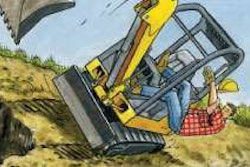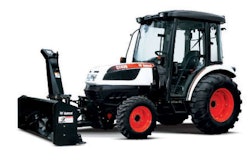Weighing the costs and benefits of non gas-powered mowers.
You might think operating your company’s gas-powered mowers doesn’t amount to much more than spitting in the ocean when it comes to emitting pollution and greenhouse gases. But when you multiply one of those mowers by 44 million – the number of gas mowers the EPA estimates in use in the United States – you have a serious air quality issue. The problem is even more concentrated in urban areas like where I live in Birmingham, Alabama, where ozone alert days throughout summer are more common than traffic jams. Older mowers are particularly harmful to the environment. A typical 3.5-hp gas mower not equipped with a catalytic converter creates as much pollution as driving a newer sedan from Washington D.C. to Boston, according to one expert.
When I decided to enter the lawn care business recently, I took the same environmental approach I use with virtually everything I do: If there is a viable green alternative, I feel obligated to take it. I purchased a propane-powered Z Force S LP ride-on zero-turn mower by Cub Cadet.
I also acquired a battery-powered push mower by Cub Cadet that runs for about two hours per charge. I admit I have to plug it in to charge it and pay Alabama Power for that, but it’s still producing a lot less air and noise pollution than a gas mower. While the three-hour operating time won’t allow a professional to cut turf all day, it works great for trimming the edges, slopes and other hard-to-reach areas where I can’t navigate the ride-on mower. A small solar panel array sufficient for charging the battery of this mower is next on my equipment purchase list.
A typical 3.5-hp gas mower not equipped with a catalytic converter creates as much pollution as driving a newer sedan from Washington D.C. to Boston.
For smaller yards, I even use an old-fashioned push reel mower that works great, gives a clean cut, emits no pollution and is whisper quiet. Plus, it’s great exercise and is nearly maintenance free.
Following is a breakdown of what I learned as I explored the advantages and disadvantages of several alternatives to gasoline-powered mowers.
Diesel
The Grasshopper Company makes a strong case for “clean diesel power.” The first diesel-powered, zero-turning radius commercial riding mower was introduced by Grasshopper in 1983, according to Ray Garvey, marketing coordinator for Grasshopper. He explains the company’s decision was based on diesel’s ability to provide more power than gasoline engines with similar displacement.
A diesel engine’s fuel economy, low maintenance and longer replacement cycle outweigh higher manufacturing costs.
“Diesel engines must be built to withstand a higher compression ratio, and thus are generally stronger, heavier and more robust than their gasoline counterparts, and able to withstand far more stress than gasoline engines” Garvey says.
Clean diesel has eliminated 99 percent of black carbon diesel emissions.
When comparing gasoline and diesel engines with similar displacements, the diesel engine will initially cost more due to its heavier construction, but the fuel economy, ease of maintenance and longer replacement cycle of a diesel engine outweigh higher manufacturing costs.
The higher compression ratios found in diesel engines enable them to operate at lower RPM, while producing more low-RPM torque, which in turn allows faster ground speeds to do the same work as a gasoline engine. Simply put, a diesel-powered mower is able to keep its blades turning at maximum efficiency, while traveling at higher ground speeds.
“Because of decades-old image misconceptions, diesel has been referred to as a ‘dirty’ fuel,” Garvey says. “However, recent improvements in diesel technology address emissions, noise and fuel economy. For example, new refining techniques – brought about in part by government regulations – have significantly lowered sulfur content compared to years past.”
Propane / CNG
Propane fuels your camp stove and patio grill because it burns efficiently and is easy to store safely. A propane mower burns fuel with an ordinary internal combustion engine but eliminates the inefficient carburetor and choke needed to turn liquid gasoline into a usable, vaporized form. Tanks and canisters hold propane compressed by high pressure into liquid. The propane becomes a gas as it travels through the fuel line or reaches a pressure regulator. A series of spring-loaded valves lowers the force uniformly so the gas enters the engine in a steady flow.
Using a propane mower can reduce emissions by more than half.
Propane doesn’t deplete the ozone, according to Bernardo Herzer, president of Lehr, which manufactures a line of propane-powered push mowers, blowers and string trimmers. Herzer says propane equipment produces 97 percent less particulates and 96 percent less carcinogens than gas. As local communities declare ozone action days when conditions indicate a high risk of ozone levels, they may prohibit gas-powered mowing activities until those conditions disappear. Having a propane or CNG mower in your fleet might allow you to keep mowing while your gas-powered competitors sit idly by.
“The immediate impact of propane is reduction in ozone-forming emissions by greater than 50 percent,” says Tony Weber, brand manager for BOB-CAT. “Also, there is no fuel spillage when refueling, and propane doesn’t go bad like gasoline. So you don’t have to worry about shelf life.” The EPA estimates 17 million gallons of gas are spilled every year by people filling up their lawn equipment. Propane is sold in sealed containers, so there is no evaporation or spills, and it doesn’t seep into underground aquifers as do spilled gas, diesel and oil.
Because propane burns more cleanly, there are less deposits and impurities, which translates into extended engine life.
Propane offers other advantages, as well. About 80 percent of propane is produced in the United States, and another 10 to 15 percent comes from Canada, so running on propane can reduce our dependency on foreign energy sources. The U.S. Department of Energy offers incentives, such as fuel excise tax credits of 50 cents per gallon for equivalent CNG and LPG fuels, in an effort to encourage the use of alternative fuels.
Hustler’s Zeon electric mower has up to 80 minutes run time, enough to mow 1 acre.
Another DOE initiative, the Clean Cities Program, is designed to help build a larger refueling infrastructure for CNG and LPG. While propane critics point out the fuel is not as available as gasoline or diesel, propane service centers are widely available across the United States, and many of those will set up on-site storage tanks or make deliveries right to your door, exchanging empty tanks for full ones.
Electric
Electric mowers come in two varieties – battery-powered mowers and plug-in mowers. To avoid the inevitable cut power cord, batteries are the way to go. They have drawbacks, including limited endurance, reduced torque and increased weight. The source of electricity used to charge an electric mower determines its carbon footprint. It’s estimated from 50 percent to 80 percent of electricity on the U.S. power grid is derived from eco-unfriendly coal. Of course, if your electricity is supplied by solar, wind or a hydroelectric power, then an electric lawnmower is much cleaner. Some innovative LCOs have borrowed engineering from the RV market and attached solar arrays to their cargo trucks to allow them to charge electric mowers whenever they are parked on the trucks.
Electric mowers require virtually no maintenance.
Reel Mowers
Reel mowers are the most eco-friendly. They produce no exhaust fumes, don’t need to be plugged in and produce zero emissions.
Manual-powered mowers are even more environmentally friendly than electric mowers. They have no exhaust fumes, don’t need to be plugged in, produce zero emissions – unless you count the carbon dioxide breathed out by the operator – and are less dangerous than other mowers. Since they have no engine, they are quiet to operate. Single 18- or 21-inch push reel mowers retail for around $250 to $300, so they are the least expensive of all mowers. While few professional LCOs are willing to push a reel mower all day, they work for mowing patio home lawns or trimming areas where bigger mowers won’t reach.
They have no exhaust fumes, don’t need to be plugged in, produce zero emissions and are less dangerous than other mowers.
For increased production, gang reel mowers with three, five or seven reels are an option. A seven-reel gang with a frame allowing you to raise the unit and fold up the outer four gangs for transporting is not cheap. The ProMow Model Gold 12000 7-gang unit retails for around $4,900, plus you’ll need an RTV, ATV or other vehicle with at least 16 horsepower to pull it. The idea is you’ll save money on lower maintenance and operating time since you can mow an 8-foot swath with each pass. If you want to go more eco-friendly than a reel mower, you’d have to consider sheep. m
Gas
Pluses: readily available, low engine cost
Minuses: contributes to pollution and ozone depletion, burns limited resource fossil fuel, fuel is costly, engine is high maintenance, relies on foreign oil, fuel is volatile, fuel can spill
Diesel
Pluses: burns cleaner than in past, low maintenance, long engine life, fuel efficient, good torque at low RPMs
Minuses: noisy, still contributes to pollution and ozone depletion, relies on foreign oil, fuel is costly, burns limited resource fossil fuel, higher initial engine cost, fuel can spill, hard to start when cold
Propane
Pluses: longer engine life, does not contribute to ozone depletion, produces little pollution, produces little carcinogens, fuel delivery often available, fuel does not spill, less expensive and more stable than gas prices, most propane produced domestically, easy to start when cold
Minuses: not as available as gas or diesel, fuel is volatile
Compressed Natural Gas
Pluses: produces little pollution, low maintenance, less expensive than gas, easy to start when cold
Minuses: fuel not readily available
Electric
Pluses: quiet, can use green fuel sources such as solar or wind, low maintenance—no belts, filters or fluids
Minuses: batteries are heavy, plug in type easy to cut cord, limited running time, contributes to pollution if relying on coal-fired power plants
Reel mowers
Pluses: low maintenance, low cost, wide cutting path with gang reels, quiet, requires no fuel, no pollution, clean cut, safe
Minuses: push mowers require stamina, gang reel mowers require vehicle to pull them
Eco-Mowers & All the Trimmings
Check out totallandscapecare.net to learn more about clean diesel, propane and other alternative powered mowers, plus related government energy and environmental programs.











